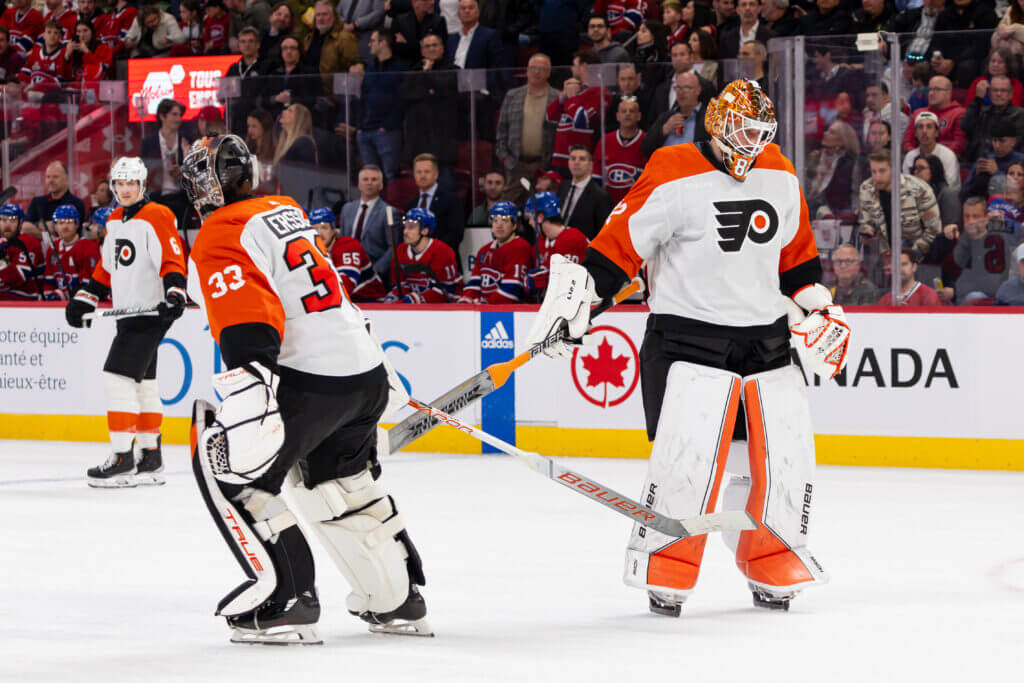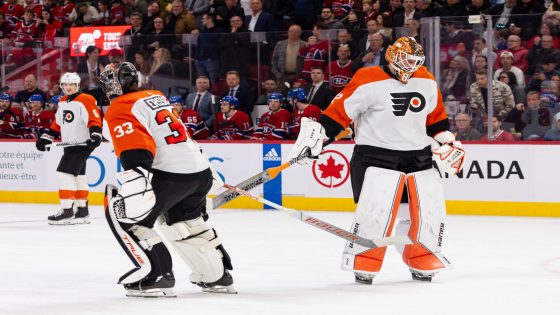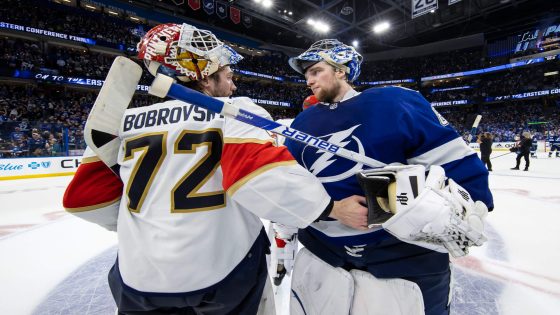
For as much as the Philadelphia Flyers’ late-season free fall was both concerning and disappointing, the final three games — in which they managed to keep the playoff race compelling — did surely provide at least a slight organizational sigh of relief.
It starts with goalie Samuel Ersson, who was as much of a reason as anyone for the team’s 0-6-2 losing streak, but then was arguably their best player in wins over the New York Rangers and New Jersey Devils and in the season finale to the Washington Capitals, a 2-1 loss in which the game-winning goal was scored into an empty net.
“I do think so, it helps,” Ersson said last week after the Flyers’ final gathering, when asked if that late resurgence will help him mentally into the offseason. “I feel like we can, or I can, hold my head a little bit higher. … (The eight-game losing streak) was a tough stretch and it happened at a tough time of the year, but I think coming out of it we did make a valid push. I definitely learned from that.”
Ersson, 24, will have the inside track to the Flyers’ No. 1 role in 2024-25, in what will be the first of a two-year, $2.9 million contract. And, his No. 2 will almost certainly be Ivan Fedotov, the 27-year-old Russian who signed a two-year, $6.5 million contract extension on Tuesday, a big chunk of change for a player who is still essentially a project.
The Flyers’ goalie tandem could be set for the next two seasons. It will allow more time for the prospects to develop, too, including 2021 third round pick Alexei Kolosov, who recently joined the Lehigh Valley Phantoms and who could be the AHL club’s No. 1 going into next season. Along with Carson Bjarnason and Egor Zavragin, second- and third-round picks, respectively, in the 2023 draft, “I think the goaltending is looking good for many years to come,” general manager Daniel Briere said on Friday.
We’ll see. In what is the most difficult position in the NHL to project, Briere does seem to have a few lottery tickets that could pay off eventually.
The immediate future is tough to project, too, because while there were some positives to take away from 2023-24 when it comes to the goaltenders, whether the Ersson-Fedotov duo will be strong enough to put the team in a position to remain in the hunt for the playoffs next season still seems like a significant question.
It starts with Ersson, who had a tremendously up-and-down campaign.
His first three appearances were a disaster, as Ersson allowed 14 goals on just 59 shots. But from Nov. 3 up to the start of that eight-game losing streak in late March, Ersson was 21-12-5 with a .906 save percentage and 2.49 goals-against average. Solid numbers, especially considering he was thrust into the No. 1 role after the All-Star break due to Carter Hart’s departure.
That was followed, though, by him going 0-4-1 with a horrid .787 save percentage in six games from March 24 to April 9. But then Ersson allowed just two total goals over the final three games, on 62 shots.
“I think I had some tough stretches, and I also felt like I had a long stretch where I think I played well, consistently, over a period of time,” Ersson said. “I feel like that is the key for me, and to be impactful player in this league is to be, (is) to have your low as high as possible, and try to stay consistent.”
Regardless of that inconsistency, coach John Tortorella has been a steadfast proponent of Ersson, dating to the 2022-23 season when the goalie was just breaking into the league. Tortorella admitted that he overplayed Ersson down the stretch when he didn’t have any other reliable options, and has said on multiple occasions that he doesn’t apologize for it.
But it also makes any evaluation of Ersson a bit more complicated.
“I just think he’s made tremendous strides,” Tortorella said. “There were struggles, because I played the hell out of him. … But the way he answered at the end, I’m glad he can hang his hat on that.”
Said Briere: “We put Sam Ersson in a really tough position, and I was really impressed how he handled it.”
Former Flyers goalie and current Buffalo Sabres/TSN analyst Martin Biron kept an eye on his former team and its goalies over the final few months. Ersson’s fatigue level — he played in 31 of the Flyers’ final 37 games — was evident to Biron.
“I think with Sam, he’s a really nice, technical, structured goaltender,” Biron said. “But he got to a point where I felt like there was not as much pop in his game as he had in the first part of the season.”
Pop? How so?
“When you watch a goalie, a lot of it is lateral movement and quickness,” Biron continued. “But also I felt like he was getting beat on clean shots, too. When Sam is in position and he’s there early, and he’s set, he usually makes the save. But when he got there like a split second late, or wasn’t fully set, it becomes harder to make the save.
“I thought that was a big thing for him late in the season, where he got there just a quarter of a second late, and all of the sudden the save that you used to make, even though it’s a hard save, you’re not making them because you’re just losing a fraction of a second in your movement. And that’s OK, that’s going to happen.”
Regardless, Biron, like those in the Flyers organization, suggested that Ersson has real potential.
“I think this, overall, was a really good season for him,” Biron said. “The numbers are not going to say ‘wow,’ but it’s the experience, it’s the playing, the being a No. 1 — it’s all going to help him moving forward.”
Biron got an close-up look at the 6-foot-7 Fedotov, who made his first career NHL start in Buffalo on April 5. It didn’t go well. Fedotov allowed four goals on 19 shots in a 4-2 Flyers loss, and four days later in Montreal, he allowed another four goals on just 13 shots before he was pulled in the second period.
Fedotov, like every NHL rookie, was goaded by his teammates into taking a solo lap during warmups before that game against the Sabres. Biron noticed something about him right away.
“He’s not a good skater, and he’s going to need to work on that a ton to be able to compete in the National Hockey League,” he said. “Very much like when (former 6-foot-7 NHL goalie) Ben Bishop, when he started his career — he was big, he covered the net, but when you get to the NHL, skating and movement is important. When you never really had to rely on moving, and on really working on it because your size really allowed you to make saves, you don’t have to do it.”
That’s not necessarily something that’s going to come overnight, either. Fedotov’s adjusting to the level of play in the NHL could be a season-long project. A league source said in March that the goalie plans to stay in the area all summer to work with team personnel, presumably to work on all of the parts of his game that will need to improve or change. Tortorella said that he’d like Fedotov to “get in better shape” than he was after his unconventional path finally brought him to the NHL in late March.
“Everybody’s got a different kind of road map when it comes to how they develop and how they adjust, but usually, you think one year, you take a step in the right direction, you play a season, you make improvements. In the second year you really are fine tuning everything,” Biron said. “I think he can improve in one summer. I don’t think it’s going to be where ultimately everybody would say, yes, this is where we need to be right away.”
In that sense, Fedotov is much like the Flyers team as a whole. There is potential there for long-term success, but it could still go in either direction.
(Photo of Samuel Ersson and Ivan Fedotov: Vitor Munhoz / NHLI via Getty Images)



